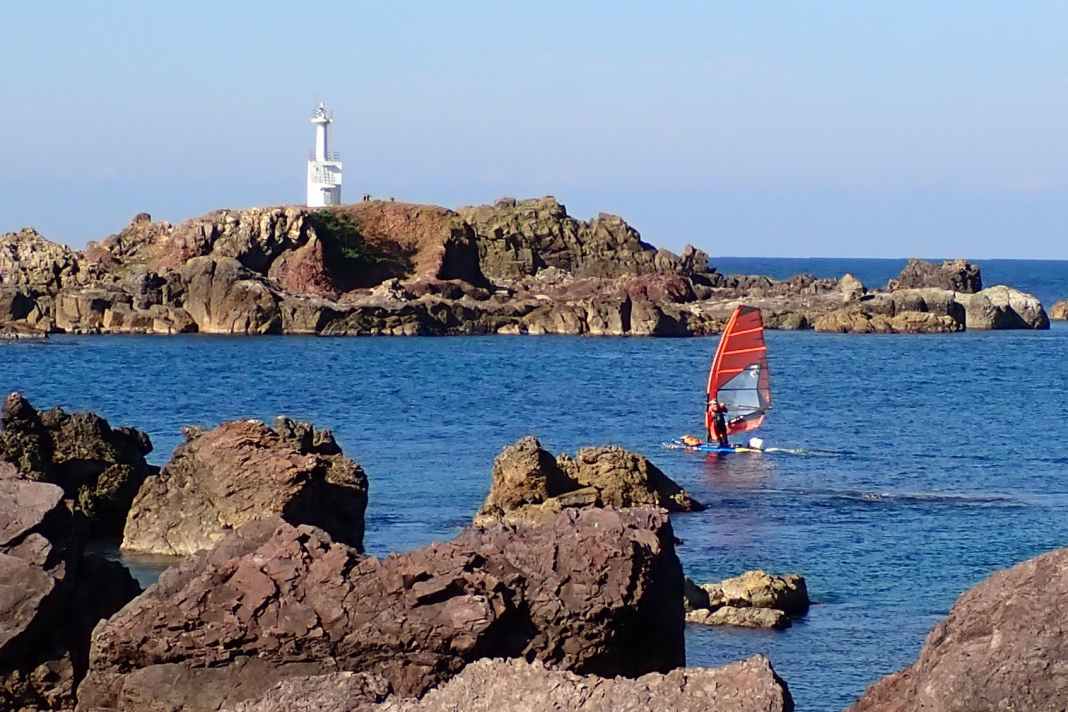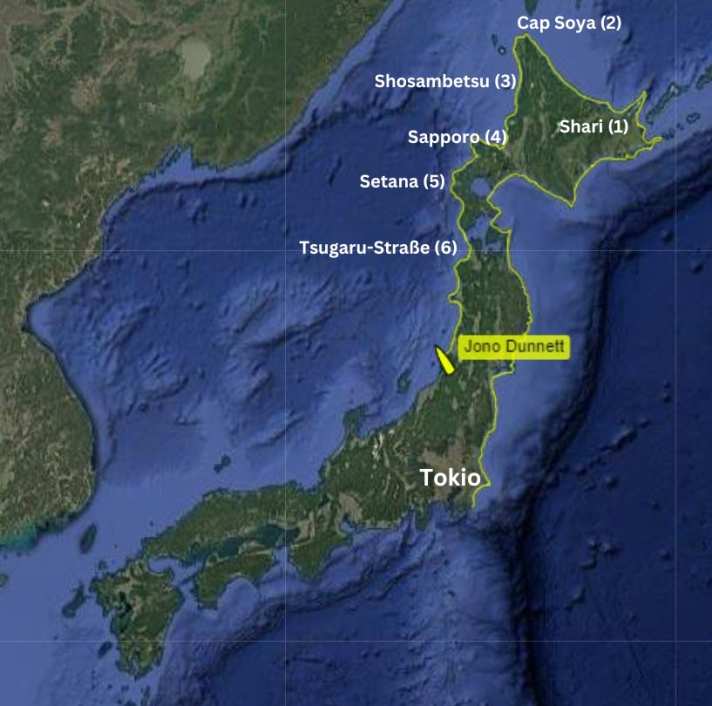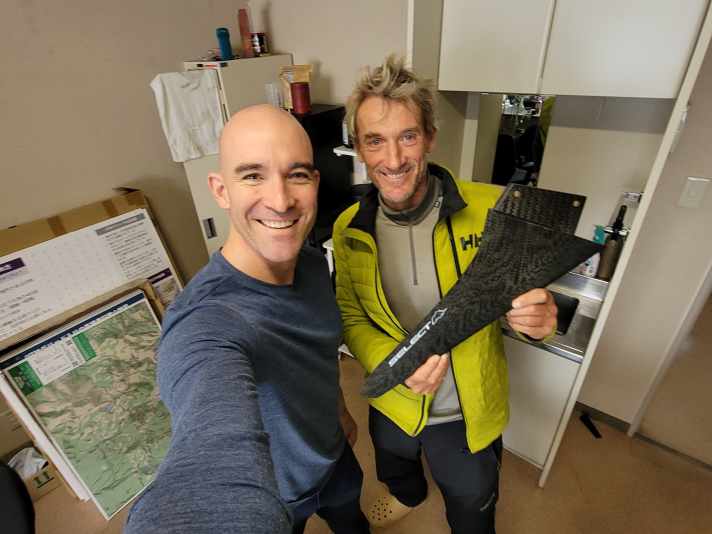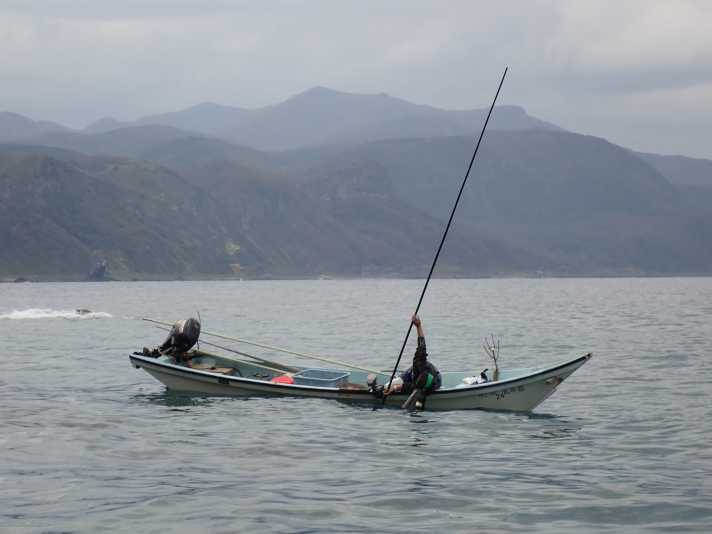





Almost nothing is thrown away in Japan, even though there are rarely rubbish bins on the streets. The cultural norm is that you take your rubbish home with you. I think it's good that people are responsible for their own rubbish, but in my case, with a ruined 8.5 square metre sail to dispose of, it wasn't practical. The only place I could find a rubbish bin was a supermarket, but the bin openings in the konbinis are deliberately kept small. So it was with a deep sense of guilt that I began to dismember my faithful companion...
You may remember from my last update that the original sail came to a sad end at a barbed wire fence in Shari (1) found. A sudden gust of wind had flung it there, breaking the mast and damaging the board. Unifibre and Loftsails got me a replacement as quickly as possible, but because of the holidays the wait was frustratingly long. The delay at least allowed me to repair the board by perfecting the technique of pre-preg carbon repair using commercially available quick epoxy from the DIY store. During this time, I also visited the neighbourhood konbinis several times a day, surreptitiously disposing of a small bag of mono film each time.

Windsurf Round Japan - what has happened so far:
New courage with new material
When the replacement material arrived, I was happy that I could keep the lower part of the mast and use it with the new upper part. The new sail, a 7.8 square metre switchblade from Loftsails, rigged beautifully and gave me new courage to set off again
The coast of the Sea of Okhotsk in Hokkaido is very remote and enclosed by pack ice in winter. So I didn't want to hang around and was lucky enough to catch favourable conditions and reach the next headland in just six legs without losing a day. The terrain on this leg was very flat, which meant that the wind had few obstacles and I was able to sail close to the coast to avoid the worst of the current heading east - i.e. right from the front. My goal each day was a harbour with a konbini, I worked hard to reach these supply points and surfed a record 40 nautical miles on some days. It was quite lonely most of the time, with the exception of Sarafutsu harbour, where the fishing union official was very communicative and friendly and gave me some dried salmon.
Russia within sight
Cape Soya (2) is the northernmost point of Hokkaido. The Japanese refuse to call it the northernmost point of Japan because they consider the Russian-controlled islands of the "northern territories" to be theirs. The dispute over the islands has been ongoing since the Second World War and has prevented Russia and Japan from signing a treaty.
As I rounded the cape, I came close to the Russian island of Sakhalin and could see it clearly. As I was afraid of being pulled north-eastwards by the strong current, I stayed close to the shore. To the west of the cape, I found myself on an extensive reef plateau where the water was too shallow to windsurf normally. Herons fished and seals lazed around while I stood on the nose of the board to lift the fin and head for deeper water. Despite numerous rock hits and travelling over reefs, my G10 Select fin held up.
However, it is too straight for coastal trips in Japan because it gets caught too easily in the many fishing nets. I have made hundreds of detours around the nets and worked my way over hundreds of nets. The nets slowed me down - often abruptly - and I have to keep them constantly in the back of my mind when I'm travelling. Most of the fishing nets were in the Nemuro Strait, but there are still very few days that go down in the logbook as "net-free". A weed fin would slip over many of the nets, but how was I going to get one as robust as my existing fin? I called Select, who got straight to work, designing a fin specifically for expeditions like mine and milling it from military grade carbon plate. Thank you Select!

A wall of driftwood and rubbish on the beach
Now we headed south, on the west side of Hokkaido. The terrain was low and the water was much warmer. I could surf along the beach and observe the logs and fishing gear that had washed ashore: a barricade, piled high and kilometres long, like a border wall. I tried to imagine what this coastline would have looked like to our ancestors or to the indigenous Ainu people who lived here long before the modern Japanese. The wood would undoubtedly have been welcome spoils. Perhaps they would have collected it and the beaches would have been quite empty? Today, nobody cleans the beaches any more. The plastic is slowly degrading and becoming our legacy to the planet.
I could see the logs and fishing gear washed ashore: a barricade, piled high and kilometres long, like a border wall.
When the fine weather arrived, I set off immediately, but was soon forced to reschedule: first my Crocs were lost at sea, swept away during a windy upwind course. Then - while gliding fast between big waves - I was slowed down by an invisible, unmarked floating line. The board was damaged, but fortunately the rig survived the fall, so I was able to sail into a harbour instead of being washed downwind onto a shore where the waves were crashing against concrete blocks.
Overwhelming hospitality of the Japanese
By Japanese standards, the harbour was Shosambetsu (3) small and cosy: in the middle of the homes of the local fishing families, instead of being remote and secluded. I met the friendliest people. They rolled out bed linen for me in the mezzanine of their wooden garage, put on coffee, did my laundry and later invited me to their home for food, beer and sake. For these people, hospitality was a matter of course. Again, I was able to observe the connection between the way people live and the place they live in. Where infrastructure fosters connection and community, connection and community thrive.
I had to fight hard for every nautical mile as the terrain became mountainous again. The wild, inaccessible, boulder-strewn coastlines reminded me of Shiretoko, and I often imagined that the darker rocks were bears roaming the shoreline. The conditions for surfing were very different. Over the course of a day, I regularly experienced winds that fluctuated between zero and 25 knots or even more. I had to use all my skills, but it was always a great sense of achievement when I could make miles "against the current", for example in strong headwinds, choppy seas or no wind at all.
The windsurfing scene supports
Sapporo (4) is the largest city on Hokkaido, and it was here that I met up with my contact Rob, who holds the Guinness record for the longest skateboard journey. Rob presented me with the customised fin that Select had sent to his address and a pair of Crocs.

Next came the mountains of the Shakotan peninsula. Thanks to a perfect downwinder, I reached my destination in one day, and in three more days I was round. On windless mornings near the harbours, I saw fishermen leaning over the sides of their canoe-like boats. They use a mask (or a "lookbox") to see underwater and use a long stick to poke abalone, a type of large sea snail, from the rocks. My first abalone - which I got from a friendly fisherman I paddled past - will go down in history as the culinary highlight of the trip.
My first abalone will go down in history as the culinary highlight of the trip.
The high spirits and challenging conditions continued all the way to the south-west corner of Hokkaido. A wild leg in strong offshore winds ended with a chance encounter with local windsurfers in town Setana (5). Shino-san and his friends initially decided to support me on the next stages to Esashi. However, they organised for me to receive support from land as far as Matsumae, from where I finally reached the Tsugaru Street (6) would cross back to Honshu. This support reminded me of my experiences in Europe and shows that the windsurfing community really knows no borders.
Reunion with Yumiko and forced break in South Korea
We waited three days for a favourable opportunity to cross, and then I was able to cross without incident. Even close to Hokkaido I saw voracious tuna, and in the middle of the strait I had excellent gliding conditions. It was much easier to surf between the islands than along the highlands before and after.
It was much easier to windsurf between the islands than along the highlands before and after.
The reward for reaching Honshu was a reunion with Yumiko. She has since followed me in her little red car and we sleep in a tent wherever I go ashore. It doesn't feel like I'm without support or even on my own at the moment, but I can live with that. I have no problem with the fact that the journey has different phases. Between some violent and cold storms, we travelled a good distance south together until my visa, which was about to expire, forced us to abandon the first round.
The tracker is currently about 40 nautical miles north of Niigata. According to a very rough estimate, I have sailed halfway round Japan. The Select fin has effortlessly skipped dozens of fishing nets, and the 7.8 sail is proving to be the ideal size for this time of year. As my visa has expired, this update comes from South Korea, but I hope to be back in Japan soon and - weather permitting - to continue sailing before winter!
Follow Jono Dunnett in the live tracker
At this point, you will find external content that complements the article. You can display and hide it with a click.

